04 Jan 2020 | Reading time: ~6 min
HackTheBox - OpenAdmin [Easy]
#HackTheBox #Easy #Linux #code-review #lateral-movement #port-forwarding #ssh-keys-cracking #GTFObins #OpenNetAdmin #nano-privesc #command-injection #RCE #password-reuse #hardcoded-credentials #B2R
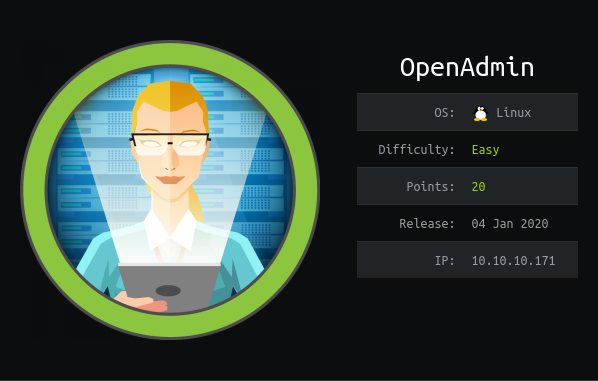
Table of contents
- Improved skills:
- Used tools:
- Introduction & Foothold
- Lateral movement to Jimmy
- Lateral movement to Joanna
- Privilege Escalation
- Trophy
Improved skills:
- Enumeration
- Apache configuration review
- Code review
- Lateral movement
- Port Forwarding
- SSH keys cracking
- nano privilege escalation (GTFO)
Used tools:
- nmap
- dirbuster
- searchsploit
- metasploit
- pspy64
- SwitchyOmega
- ssh2john
- john
Introduction & Foothold
Let’s start as every time with an nmap scan:
root@kali:~/Documents/CTF/Machine/OpenAdmin# nmap -sV -A -O 10.10.10.171
Starting Nmap 7.80 ( https://nmap.org ) at 2020-02-11 11:28 CET
Nmap scan report for 10.10.10.171
Host is up (0.060s latency).
Not shown: 998 closed ports
PORT STATE SERVICE VERSION
22/tcp open ssh OpenSSH 7.6p1 Ubuntu 4ubuntu0.3 (Ubuntu Linux; protocol 2.0)
| ssh-hostkey:
| 2048 4b:98:df:85:d1:7e:f0:3d:da:48:cd:bc:92:00:b7:54 (RSA)
| 256 dc:eb:3d:c9:44:d1:18:b1:22:b4:cf:de:bd:6c:7a:54 (ECDSA)
|_ 256 dc:ad:ca:3c:11:31:5b:6f:e6:a4:89:34:7c:9b:e5:50 (ED25519)
80/tcp open http Apache httpd 2.4.29 ((Ubuntu))
|_http-server-header: Apache/2.4.29 (Ubuntu)
|_http-title: Apache2 Ubuntu Default Page: It works
No exact OS matches for host (If you know what OS is running on it, see https://nmap.org/submit/ ).
TCP/IP fingerprint:
OS:SCAN(V=7.80%E=4%D=2/11%OT=22%CT=1%CU=31767%PV=Y%DS=2%DC=T%G=Y%TM=5E4281D
OS:C%P=x86_64-pc-linux-gnu)SEQ(SP=105%GCD=1%ISR=107%TI=Z%CI=Z%II=I%TS=A)SEQ
OS:(SP=105%GCD=1%ISR=107%TI=Z%CI=Z%TS=A)OPS(O1=M54DST11NW7%O2=M54DST11NW7%O
OS:3=M54DNNT11NW7%O4=M54DST11NW7%O5=M54DST11NW7%O6=M54DST11)WIN(W1=7120%W2=
OS:7120%W3=7120%W4=7120%W5=7120%W6=7120)ECN(R=Y%DF=Y%T=40%W=7210%O=M54DNNSN
OS:W7%CC=Y%Q=)T1(R=Y%DF=Y%T=40%S=O%A=S+%F=AS%RD=0%Q=)T2(R=N)T3(R=N)T4(R=Y%D
OS:F=Y%T=40%W=0%S=A%A=Z%F=R%O=%RD=0%Q=)T5(R=Y%DF=Y%T=40%W=0%S=Z%A=S+%F=AR%O
OS:=%RD=0%Q=)T6(R=Y%DF=Y%T=40%W=0%S=A%A=Z%F=R%O=%RD=0%Q=)T7(R=Y%DF=Y%T=40%W
OS:=0%S=Z%A=S+%F=AR%O=%RD=0%Q=)U1(R=Y%DF=N%T=40%IPL=164%UN=0%RIPL=G%RID=G%R
OS:IPCK=G%RUCK=G%RUD=G)IE(R=Y%DFI=N%T=40%CD=S)
Network Distance: 2 hops
Service Info: OS: Linux; CPE: cpe:/o:linux:linux_kernel
TRACEROUTE (using port 1720/tcp)
HOP RTT ADDRESS
1 61.58 ms 10.10.14.1
2 61.83 ms 10.10.10.171
OS and Service detection performed. Please report any incorrect results at https://nmap.org/submit/ .
Nmap done: 1 IP address (1 host up) scanned in 26.18 seconds
We can see that only two services are exposed: a non-vulnerable SSH version, and an Apache web server on port 80 with a default page.
In order to enumerate all the possible sub-pages of the site and find an entry point, let’s start a Dirbuster scan. Among the first results of the tool execution we find these records:
/
/index.php
/icons/
/music/
/ona/
Visiting each page, arrived at http://10.10.10.171/ona/ we realize that in front of us we have a vulnerable version of OpenNetAdmin, a web application for the network administration. Let’s use searchsploit to find out if there are exploits fitting this particular version… the 47772 seems to be what we need, a Command Injection on OpenNetAdmin 18.1.1. We just have to download it, import it into metasploit, set the correct parameters and run it.
Lateral movement to Jimmy
Analyzing the contents of the /etc/passwd file we notice that the main users on the box are actually two: Jimmy and Joanna.
After having take a look at the machine and launching LinEnum.sh without success, I decided to check better the processes of the machine via pspy64.
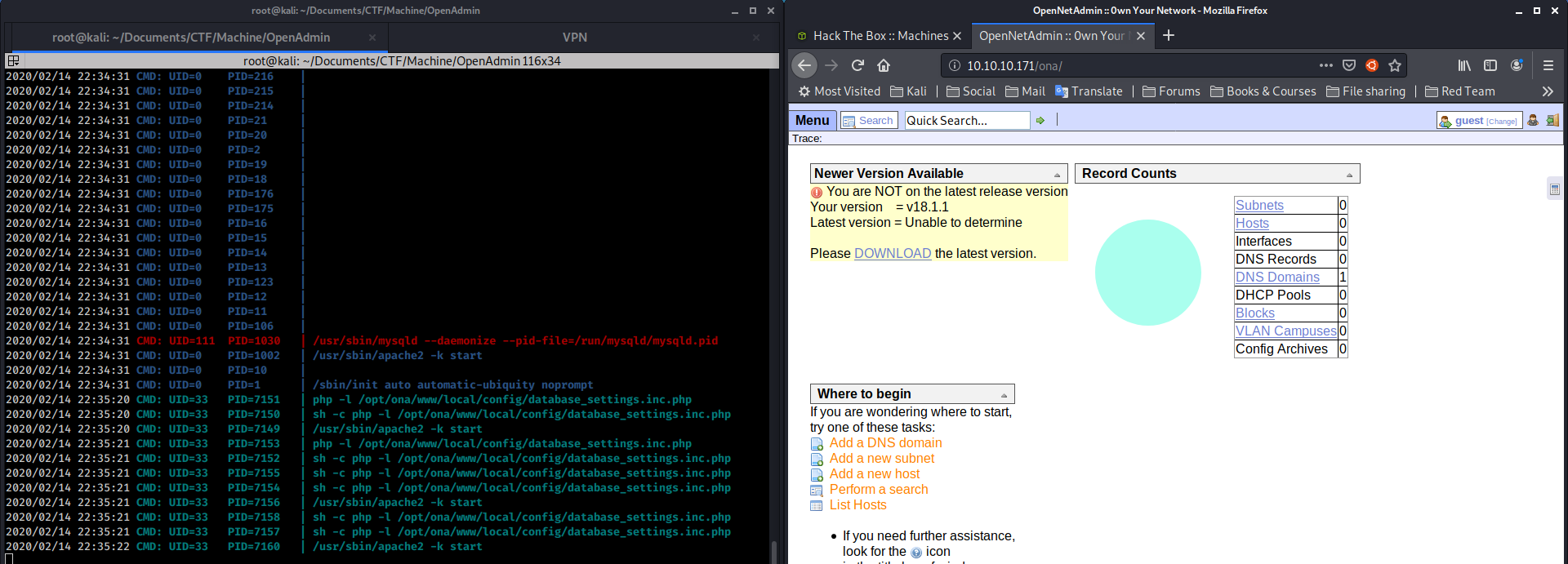
By observing the various processes, one particular line attracts my attention:
2020/02/14 22:35:20 CMD: UID=33 PID=7150 | sh -c php -l /opt/ona/www/local/config/database_settings.inc.php
I decide to analyze the contents of the database_settings.inc.php file:
<?php
$ona_contexts=array (
'DEFAULT' =>
array (
'databases' =>
array (
0 =>
array (
'db_type' => 'mysqli',
'db_host' => 'localhost',
'db_login' => 'ona_sys',
'db_passwd' => 'n1nj4W4rri0R!',
'db_database' => 'ona_default',
'db_debug' => false,
),
),
'description' => 'Default data context',
'context_color' => '#D3DBFF',
),
);
We have a password! Let’s try using it to log in as jimmy… it works!
Lateral movement to Joanna
Now that we have a shell as jimmy, our goal is to become joanna, as this user will take us to the root.
Since we have new privileges compared to before, we will be able to enumerate the machine in more depth, as for the /var/www/internal/folder, which seems to suggest the presence of a web page that can only be visited from inside the machine, so before we could not find it via dirbuster.

The confirmation is obtained from the Apache configuration file, which tells us that on port 52846 there is a virtual host running as joanna, exposing the pages contained in /var/www/internal/.
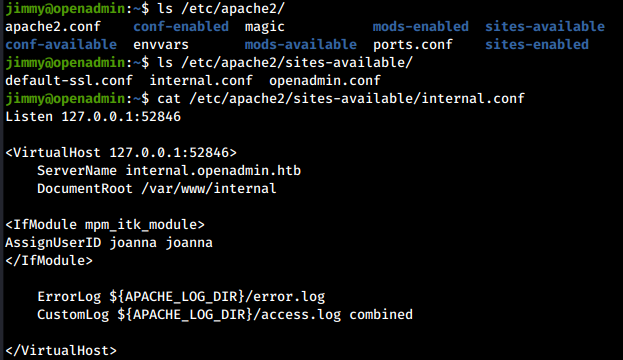
At this point, there are different ways to go over the obstacle:
- SSH Port Forwarding
- local curl
- Write a PHP shell in the
/var/www/internal/directory
In this writeup we will deal with the port forwarding approach.
I used the OpenAdmin box as an SSH tunnel on the Kali local port 12345, and through SwitchyOmega I used port 12345 as a proxy so that when I visited http://127.0.0.1/52864 I was actually visiting locally the OpenAdmin machine.
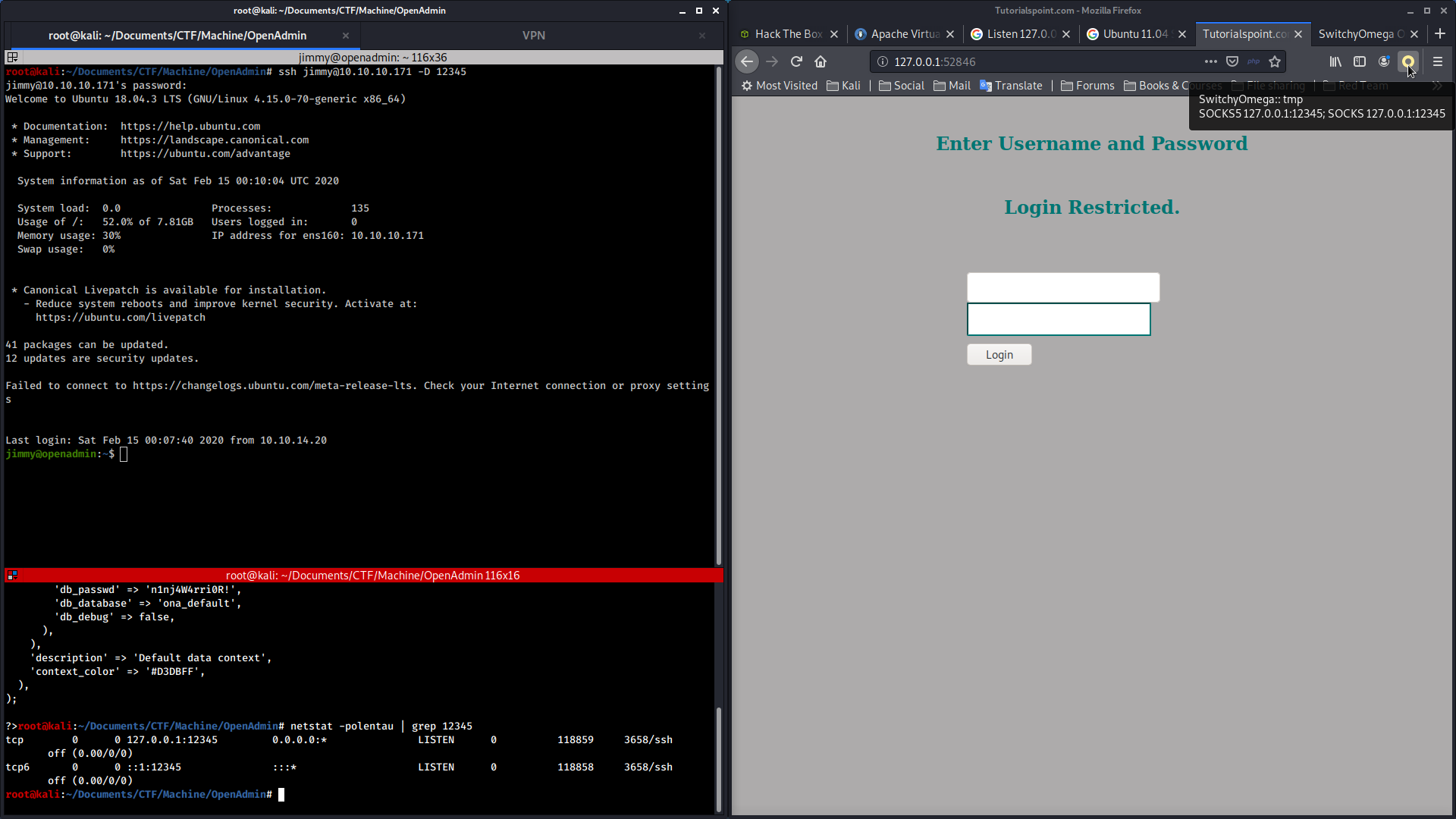
In this way we can interact with the web application as if it was an exposed application.
Having access to the /var/www/internal/folder, it was possible to review the sources contents in search of any vulnerabilities or bypass techniques. The index.php page, for example, to log in a user, checks the supplied input with a hard-coded hash:
<?php
$msg = '';
if (isset($_POST['login']) && !empty($_POST['username']) && !empty($_POST['password'])) {
if ($_POST['username'] == 'jimmy' && hash('sha512',$_POST['password']) == '00e302ccdcf1c60b8ad50ea50cf72b939705f49f40f0dc658801b4680b7d758eebdc2e9f9ba8ba3ef8a8bb9a796d34ba2e856838ee9bdde852b8ec3b3a0523b1') {
$_SESSION['username'] = 'jimmy';
header("Location: /main.php");
} else {
$msg = 'Wrong username or password.';
}
}
?>
It is therefore easy to bypass the control, either by deciding to crack the hash (which turns out to be a SHA512 containing the password Revealed), or, since we have access to the source in read/write, replacing the control with a control at will.
Once the control is bypassed, we will find ourselves on the main.php page with Joanna’s private RSA certificate shown on the video.
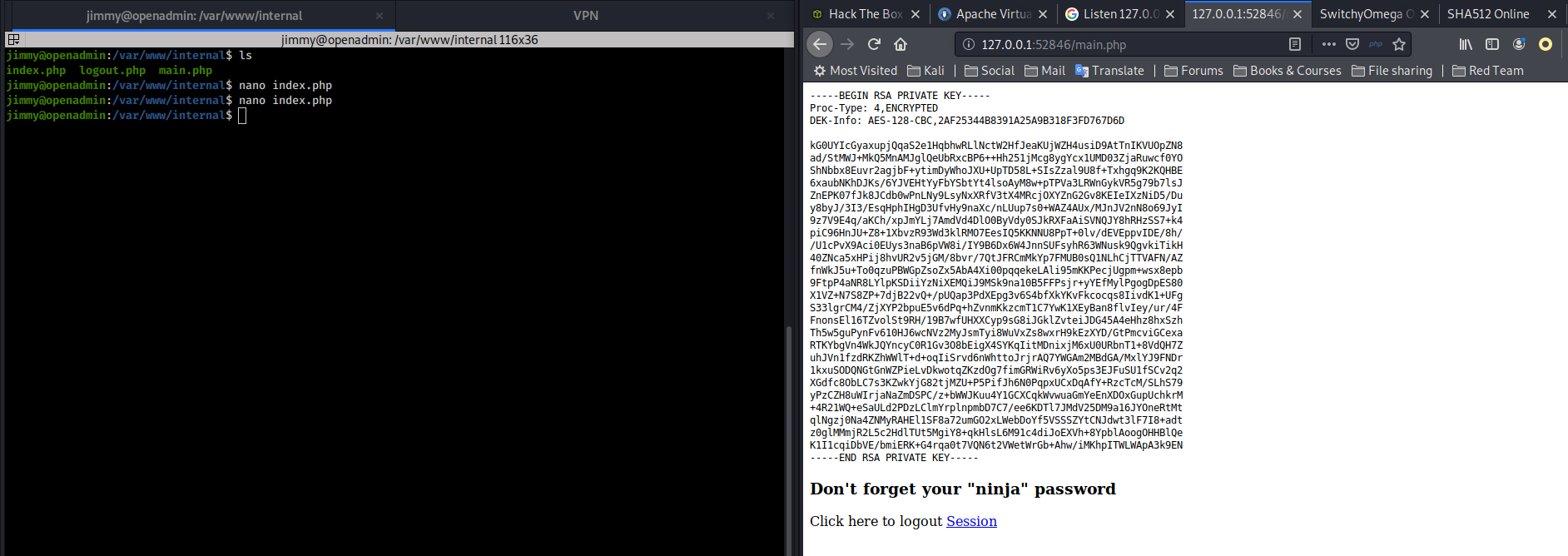
Let’s copy it into the joanna.txt file and give it to ss2john in order to generate a hash that can be cracked with john:

We have Joanna’s password!
Privilege Escalation
The Privilege Escalation process is the easiest and fastest I’ve ever seen. By running the sudo -l command we notice how the user joanna can open the /opt/priv file via the nano text editor as root user.

We just have to run the command and, within nano, use the code execution feature to be able to run commands as root!
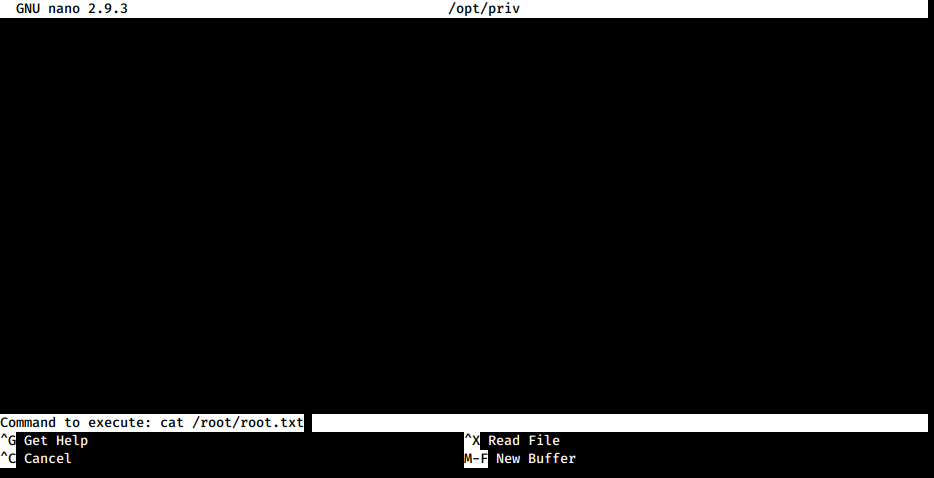
Trophy
It's never too late to start.<br>
- Me, Myself and I